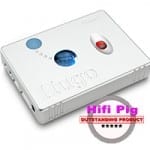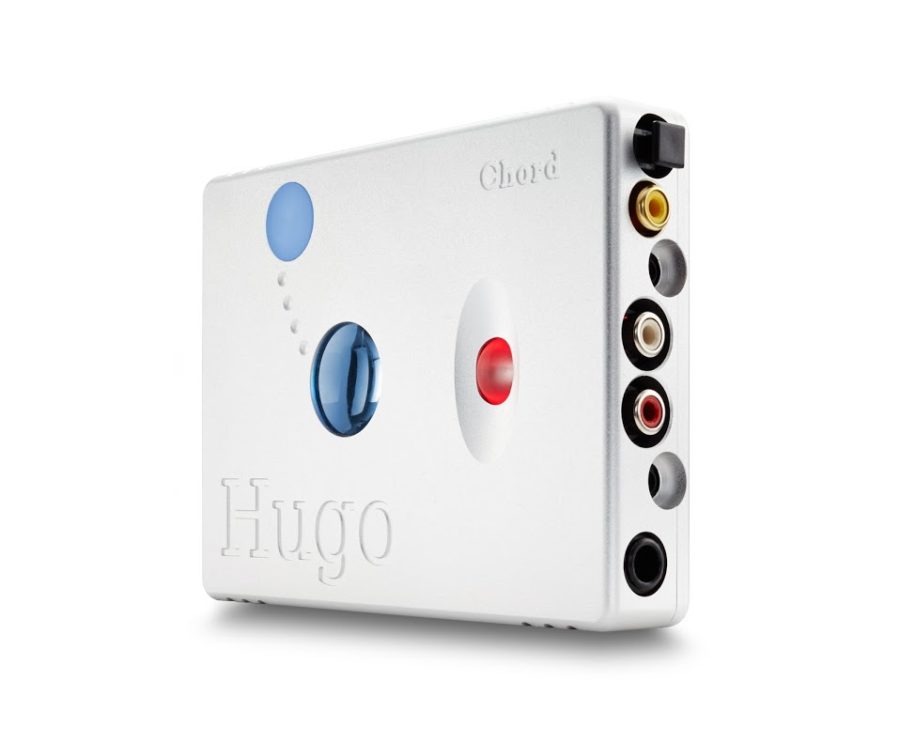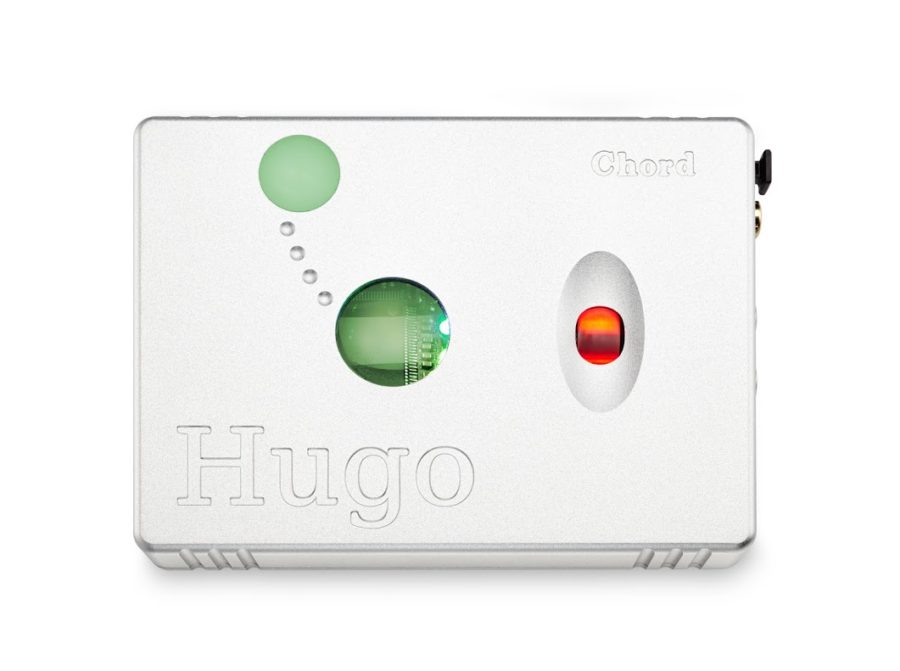At the recent Bristol Show I found myself very impressed with the new CPM2800 Amplifier from Chord Electronics driving a pair of Kef Reference One Loudspeakers. I asked the representative at the door Tom what was making the amplifier sound so different to the previous version. Tom said ‘we have made some power supply and signal path changes, but the main difference that I am hearing is the implementation of Hugo technology’.
making the amplifier sound so different to the previous version. Tom said ‘we have made some power supply and signal path changes, but the main difference that I am hearing is the implementation of Hugo technology’.
Hugo is the DAC section of the CPM2800 and what better way to single Hugo out then to get an actual Hugo from Chord. The standard Hugo is more than a DAC, it also has a high quality Headphone Amplifier integrated in its bijou bodywork.
Hugo may be a small eloquent unit but my goodness it’s features are of gargantuan proportions. No less than 5 digital interfaces including A2DP aptX Bluetooth, Coaxial, Optical and Hugo also benefits from two advanced USB inputs: one driverless input for legacy USB devices and one asynchronous high- definition USB port for operation up to 384kHz.
In addition to 384KHz PCM files, the Hugo can also process DSD 128 data using the latest DSD-over-PCM standard (DoP). Whether using Mac OS or Windows OS, Chord Electronics’ own proprietary driver software is provided, removing the restrictions of current standard operating system audio playback.
Hugo has a built-in battery-charging circuit, with a full charge reached in approximately two hours. Hugo takes no power over its USB input (as this is severely limited with many partnering products) and only takes signal data, therefore, it is fully compatible with all iPhone, iPad and Android devices. Further features include an advanced reference-grade digital volume control which remains bit perfect according to Chord.
When attempting to connect my digital coaxial cable which has spring loaded Neutrik Profi RCA connectors I found that the chassis of the Hugo prevented me from doing so, there didn’t seem to be enough clearance around the RCA socket, the same was true when trying to connect my optical cable, so USB was the default interface I had to use with sadly no other choice.
Construction of the Hugo like all Chord Electronics products is absolutely solid. The casework is precision machined from aircraft grade aluminium and comes in black or silver anodised finishes. There is a magnified circular window which gives a glimpse of the circuit board and a row of LEDs which correspond to certain functional modes. All in all a stunning little piece of equipment.
THE SOUND
My first connection to the DAC was one of simplicity. I wanted to replicate a situation whereby I wasn’t being too anal about connections and cables used. I plugged the supplied USB A to USB mini A cable from the side of the Apple wired keyboard into the DAC and fed the active Focal desktop speakers I use with a pair of RCA’s that I had to hand.
This little setup normally uses a modified Metrum DAC that has a very bespoke power supply and series regulators. The Hugo however with its internal battery and no power over USB was an interesting comparison for me to make. 
Most noticeably on first impressions was the amount of air and space around the lead vocalist and instruments. The background of the Hugo was completely black, so dark that I intently listened to many types of music as sometimes when the background is so dead it can darken and sterilise the music somewhat. This definitely was not the case, what I was hearing was an effortless sound that had stronger grounds from where the notes emanated from, instruments exuded texture and organics right through to their very core, which naturally allowed for an opening up of the soundstage, allowing it to convey many dimensions of layering.
I listened to Loreena McKennit’s ‘Mask and the Mirror’ album and her vocal was absolutely glorious. The intense power and grace which Loreena sings with in this Celtic inspired album sends shivers down the spine when heard at volume, on the desktop it was great so naturally I wanted to hear the difference when implemented into my main system.
I was prepared for a huge improvement in definition and clarity and I was wonderfully satisfied. The sound I had from the main system was clean, clear, solid and just so stable. I don’t know what and how Chord Electronics do what they do in this little box of tricks and quite frankly I don’t really care, there’s too many hang ups about technology specifications right down to resistor and capacitor implementation it often becomes a somewhat pompous affair by consumers and reviewers alike to comment on a product before they have heard it… me I trust my ears and base any decisions on the exploration of music with any new product.
Hugo develops midrange tones with absolute ease, they are crystal clear and fully fleshed out, transparent right through to the core of its detail and as articulate as a 20 year old lady of the manor fresh out of Finishing School – her posture straight and upright. I was very much taken back by how true Hugo recreated such a stable soundstage and especially the height of it during many of my favourite vocalists work, each performance showed a reflection of the singers height and presence in centre stage, all band members and room acoustics produced the boundaries to the strong features of this glorious picture.
Chord have always been able to reproduce electronic sounds faithfully and excitingly and it’s this that first drew me to their room at Bristol this year. As you know I too listen to a lot of this genre of music as well as the acoustic stuff and both are far enough removed from each other to be a great test for any piece of equipment. Tick tick tick, bass – solid, treble – resolution rich, crystal clear and playful, three dimensionality – stunning!
Dynamically the Hugo conveys big transients with flair and accuracy, there is a sense of ease from this little unit combating dynamics of other DACs in its price range so strongly and it’s battery power in relation to large toroids never seems to be a factor. Bass isn’t huge but it’s definitely explosive, tight and extended revealing great amounts of information in the upper bass regions such as the punch of a kick drum on electronic music.
Playing some trance, dance and hard house music my room was absolutely alive, the spacial boundaries seemed to disappear and the artifacts of the music just danced through, around and past the room’s edges. The intensity of the sound is stimulating and if you can sit still whilst listening to this type of music then you must be wearing velcro pants. The sheer excitement and drama the Hugo does for the listener is absolutely awesome, it makes me wonder who at Chord Electronics decided to add Hugo to the CPM2800, they surely need a pat on the back, Hugo deserves more recognition than simply associating it purely with, or as a headphone amplifier.
So, what is it like as a headphone amplifier? Errrrrrm, a mini CPM2800 in your head. It’s extremely articulate and spacious, choral pieces and big bands sound separated, brass, woodwind sets have their own groupings in the performance and individual intricacies of specific musicians can be heard above and amongst the others during busy passages. Transient slams and smaller more subtle intricacies of violin peaks were so easy to ascertain, music never seemed to be over cluttered or tempered by the enormity of the performance.,
Acoustic sound is just so clean and underpinned with fantastically natural tones allowing for decay of notes to be so true to life that the brain wanders away with it following the extension and flow of the note when it’s shocked back into the performance by the next pluck of a string or beat of a drum. I got pretty much lost in some ambient type music late one night and nodded off in my computer chair with my feet on the desk only waking up when I jolted and nearly fell off it.
The amplifier in the Hugo is very powerful driving my AKG 702’s and Sennheiser HD600’s with ease, I much preferred the Senns with the Hugo as the AKG’s are more so for monitoring duties and the Senns are for playback, they are cleaner sounding than the old reference 650’s and always much preferred by myself to them and some who may love their HD650’s may well not consider the Chord Electronics Hugo as their type of sound as they enjoy a smoother more romantic type sound – to them I’d say try it, the cohesive balance articulation and resolution of the Hugo is just so well balanced and engaging.
The volume control on Hugo is not to my liking at all. It’s a sideways on rubbery plastic rotating wheel, yes it looks cool with the changing LED lights representing intensity of levels but I find that I have to put so much pressure on it to obtain friction to move it my thumb turns white, a friend said to me when looking at it and me showing him the volume ‘wow, your pushing that hard aren’t you?’. I really appreciate the fact the volume remains bit perfect of course and it’s a niggle that one would learn to live with. I have dubbed the volume control with the name ‘Miriam’, Miriam is Hugos wife and she is that nagging type of wife that can sometimes be a pain in the backside. Next time Hugo comes out for a drink, maybe he can leave his wife at home?!
CONCLUSION
What can I say about Hugo? It’s a revolutionary piece of kit which I am just so happy is now deemed absolutely fundamental to Chord as a core product which now graces their latest amplifier as well as this well constructed, solid sounding headphone amplifier.
With enough connections to carry all your mobile devices and a laptop with you connected at all times and a battery that takes only 2 hours to charge on paper it seems well implemented and straight forward to connect to any digital device.
Somewhat more importantly though is the sound. Wondrous things happen when connecting Hugo to a speaker system, amplifier or set of headphones all of a sudden you are transported into the heart of the music and whether at loud levels or lower volumes late at night, every beat and note is projected to the listener leaving no detail veiled or subdued in any way. The sound is articulate, controlled, expressive and intense. Many genres of music are covered exceptionally well and the unit produces a soundstage which is vast and stable. All in all it’s a truly pleasing piece of kit, apart from the volume control that is.
Price at time of review: £1400
Build quality: 8.5/10*
Sound Quality: 9/10
Value For Money: 8.8/10
Overall: 8.76/10
*Reduced scoring for connections
Recommended for absolute flexibility and portability which combines a sound that belies its tiny footprint making a package that simply needs to be heard and tested.
Dan Worth
Dan in his review above has given the Chord Electronics Hugo DAC/Headphone Amplifier an overall scoring of 8.93 out of 10, which means it will now be handed over to another reviewer for further evaluation, which in this instance is Dominic.
“Tiny footprint” says Dan and he is not kidding. I got the tape measure out and it’s vital statistics are 103mm wide x 25mm high x 95mm deep, so it’s comfortably pocket sized and easily transportable. Dan has more than adequately described the technical and construction aspects of the Hugo, so will press ahead with my perceptions for you of the Chord Electronics Hugo.
SOUND QUALITY
I was primarily interested in the Hugo’s performance as a digital to analogue converter more than as a headphone amp, so was rather keen to hook it up to my resident CD spinner with a good quality glass TOSLINK connector. Oh dear. The TOSLINK input to the DAC is deeply recessed into the chassis and the outer shell of the TOSLINK plug was butting up against the Hugo’s casework so the connector was prevented from being inserted, therefore only the tip was making the merest physical contact and although the signal was getting through, it was not a firm solid reliable connection – in fact the slightest movement of the DAC or lead caused it to drop out. Somewhat miffed by this, I dug out of the spares drawer an old plastic TOSLINK lead and that managed to tenuously hang on no better than the expensive glass optical lead – and I mean precisely no better, because movement of either lead or DAC still caused it to fall out. In the end I rested a book on the cable to keep it in place.
Dan in his review couldn’t quite get to grips (excuse the pun) with the volume control, but have to be honest here I didn’t have any real issues with it, save the one time when the phone rang and needed to reduce the volume rather quickly, which was a series of rapid short stabbing fumbles on the control due to the restricted travel of “thumb actions” available for each stroke. At every other instance the control was smooth and positive, fairly easy-ish to shift the volume up or down, very precisely indeed for all that.
Surprised too that Chord have not labeled on the casework any of the controls and switches with their designated functions. It’s not exactly taxing to remember 2 push buttons, a switch and the relevance of 2 USB sockets, but it’s a finishing touch that I and presumably others too, might find welcome. The coloured LED sequences were not entirely helpful either and I just stabbed at the leftmost source select button until I heard sound through my speakers. Job done and whatever colour of LED was lit at the time bothered me not, especially so when I am colour blind.
By heck Dominic, you have given the Chord Hugo a pretty good pasting there, so have you something positive to say about it? Well, yes I have and it’s a very BIG positive. Forget all the niggles I have mentioned, this DAC just blows you away when you hear it and whether it’s housed in some fancy casework or a wooden cigar box becomes totally immaterial as a result. It is so natural sounding, yet detailed and communicative and thoroughly musical at the same time, quite unlike any other DAC I have heard previously with it’s presentation. Not easy either to pinpoint or isolate WHY it sounds so different, because it is the whole of it and not just one or more elements that makes it what it is in entirety. You still with me?
If I say “detailed” I mean exactly that, not in a spot lit manner, nor in an artificially uplifted way, not in a glaring stark way either, but the Hugo manages to uncover a wealth of detail in all genres of music, even within the busy frenetic multi-layered heavy rock or dance music that seems to confuse and befuddle other DACs, so it separates out all the musical strands into their component elements and keeps them firmly there. If I described the bass as “powerful” then I mean that as strength, tenacity and oddly enough, delicacy at the same time, because a pluck of a bass guitar string didn’t just result in a full single bass note, it resulted in hearing all the vibrations of the string and the body of the instrument itself as well, with the decay of both being heard simultaneously yet still separated. Excuse my brevity here, but if it were any more detailed than it already is, you might be able hear the guitarist’s fingerprints rustling against the strings as they played – assuming it is in the recording of course and aided immensely by the total eerie silence in the background. Midrange and vocals are truly fluid and flowing, female vocals in particular had a beguiling realism that made your hair stand on end. Every element of the music is relayed in full, but all of it entirely in proportion and most importantly, in relevance and context and that’s what I liked the most with it’s unique set of sound qualities that made compelling listening for hour after hour without any fatigue because it is so engaging and enervating in it’s musical abilities.
I am not a classical music fan by any means, but I was tempted into playing one or two excerpts (Entire symphonies are beyond me) from a compilation CD I keep solely for bashing errant spiders, to put the Hugo through it’s paces and was pleasantly surprised that the Hugo actually made it a pleasant and enjoyable listen. Brass and strings sections had a rich sonorous quality which I had not heard before and when the Timpani was struck, goodness me I felt it. One recording has a Triangle playing throughout the excerpt and I could easily follow every single strike, whereas it has tended to be drowned out and overwhelmed by the other instruments. I like this DAC, if it has made me enjoy classical music which I usually avoid, so this CD has been elevated from spider walloping duties in future, but that of course may be viewed rather differently without the Hugo in place.
The volume control operates in the digital domain and also varies the RCA analogue output level, so I found a good use for it. I have a Sheffield Labs CD of James Newton Howard and Friends which is totally uncompressed and the dynamics can overload an amplifier’s inputs, so adjusting the volume control downwards slightly gave the amplifier more headroom for coping with the highly dynamic transients found in this particular recording. The percussion on this CD is stunning and drums come across as you being just inches away from the drum set receiving the full impact, while piano had endless decay of harmonics and the body of the instrument sounded so real you could almost be standing next to it.
Now on to the headphone amplifier evaluation. I don’t have an expensive pair of headphones because I find them to be claustrophobic within a very short period of time and the “in the head” sound gives me the shudders, but I do have a budget set of headphones and the test here is can the Hugo headphone amp make this pair sound good? Yes indeed, the Hugo certainly did inject a massive dose of energy and vitality into this modest pair of headphones. The treble came across as clean and insightful, rather than the “Tish, tish, tish” sort of sound listening on headphones elicits and commonly plagued with. Bass was powerful and deep too, which has never happened before with other amps of this ilk and all the details I heard through the main system were reproduced into the cans as well. A couple of prods on the “Crossfeed Filter” button managed to eradicate the “in the head” stereo effect and I wish more headphone amps could incorporate a similar feature. All in all, I would say the Hugo gives a level of sophistication that no other headphone amp I have heard to date can muster or emulate.
Chord make great play of the Hugo’s long battery life and it would be remiss of me not to see if their claims stand up to scrutiny. I unplugged the charger and hooked up to my PC through the unpowered USB input playing non-stop Spotify tracks, searching for some new music purchases. This was interspersed with listening on my mobile phone, again through the unpowered USB connection. I racked up nine hours of music on the one charge and still no signs of the Hugo yelling out for more juice for it’s battery, signified by a sequence given out by one of the internal LEDs.
CONCLUSION
In true Chord signature fashion, it walks a path well away from the herd in it’s unique design concept, but there needs to be a rethink regarding the connection socket issues, especially so the TOSLINK connection. As I understand it, Chord have already moved the analogue output RCA sockets from an earlier variant because they were too close together and they should follow suit with addressing the connection problems both myself and Dan experienced with the current Hugo while under review.
Setting that aside though, we have a product in the Hugo that is far more than the sum of it’s parts, so I will table the positives:
It is compact and portable, has a stunning amount of battery life and for good measure the charger itself is very compact as well and that too will fit into a pocket or handbag. So, provided you can find a socket to charge up to full capacity in under 2 hours you shouldn’t be left high and dry with a flat battery at any time.
It has a resolving and articulate amplifier section which should power almost any headphones you can care to name, right from ear buds up to serious power hungry audiophile quality level headphones. The digital pre-amplifier section is again a true stunner in performance with it’s unique bit-perfect volume control.
The real star of the show however is the DAC section which is stunning in every way imaginable, equally at ease on the move with headphones, as it is sat in the home rack doing the job of a top flight DAC in a sophisticated hi-fi system with portability as an added bonus. Chord obviously think so too, because they have standalone DACs now released with the same Spartan 6 FPGA chipset as the Hugo and as Dan has rightly observed, it is also being incorporated into their amplifier products too.
Truly untouchable in performance terms.
Sound quality: 9.1/10
Value for money: 8.9/10
Overall: 8.8/10
The “Build quality” scoring is referenced to the TOSLINK connection problem noted in the review.
Recommended for: Those looking for a high performing digital to analogue convertor with the added bonus of portable headphone listening. An audition is strongly recommended.
Dominic Marsh


















































































































































































You must be logged in to leave a reply.